LG ELECTRONICS LGC800W SINGLE-BAND CELLULAR CDMA PHONE User Manual SVC Manual 800W
LG Electronics, Inc. SINGLE-BAND CELLULAR CDMA PHONE SVC Manual 800W
Contents
- 1. Users Manual
- 2. Service Manual
Service Manual
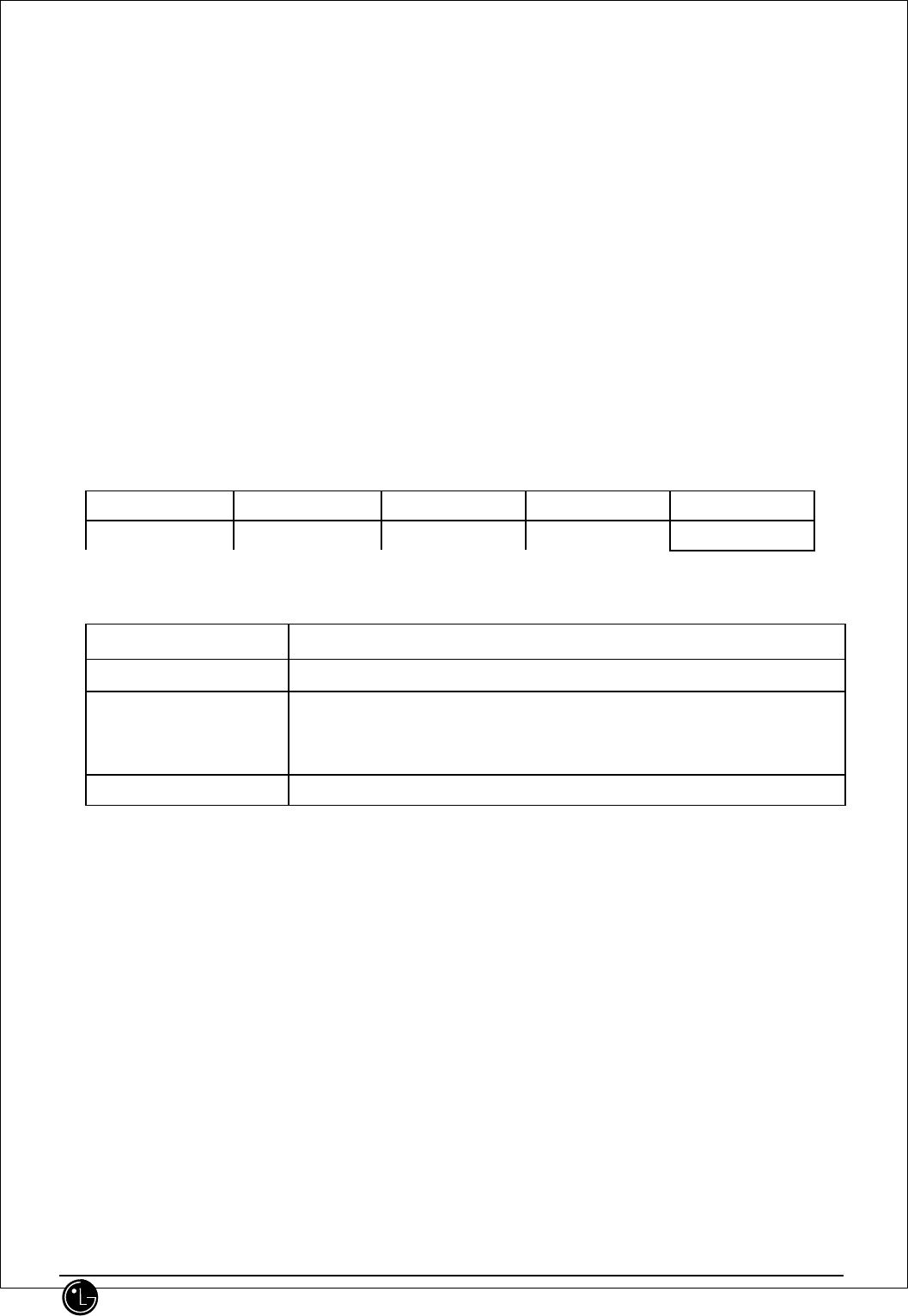
1 LG Information & Communications, Ltd.- 1 -
Features of Mobile Subscriber Radio Telephone Set
(LGC-800W Type)
1. Wave Type
• Digital : G7W
2. Frequency Scope
• Send Frequency : 824.820~848.190MHz
• Receive Frequency : 869.820~893.190MHz
3. Rated Output
• 0.2W
4. Output Conversion Method : This is possible by correcting the key board channel.
5. Voltage and Current Value of Termination Part Amplifier(Catalogue included)
Product Type Name Voltage Current Power
PWR AMP RF2132 5.0V 400mA 0.63W
6. Functions of Major Semi-Conductors
Classification Function
MSM3000-PBGA Terminal operation control and digital signal processing
FLASH MEMORY
& STATIC RAM
(MB84VA2103-10P8)
Flash Memory (16Mbit) Õ Storing of terminal operation program
SRAM (2Mbit) Õ Temporary storing of the data created while busy
IFT3000/IFR3000 Converting IF signal into baseband signal and analog signal into digital signal
7. Frequency Stability
• ¡¾0.5PPM

2 LG Information & Communications, Ltd.- 2 -
CDMA PORTABLE CELLULAR PHONE
LGC-800W
SERVICE MANUAL

LGC-800W
LG Information & Communications, Ltd. - 1 -
Table of Contents
General Introduction
.............................................................................................................................................................. 2
CHAPTER 1. System Introduction
1. System Introduction ................................................................................................................................... 3
2. Features and Advantages of CDMA Mobile Phone .................................................................................... 4
3. Structure and Functions of CDMA Mobile Phone ..................................................................................... 7
4. Specification ............................................................................................................................................... 8
5. Installation ................................................................................................................................................ 13
CHAPTER 2. NAM Input Method(Inputting of telephone numbers included)
1. Telephone Number Input Method ............................................................................................................ 13
2. NAM Program Method ............................................................................................................................ 16
CHAPTER 3. Circuit Description
1. RF Transmitter and Receiver ................................................................................................................ 17
2. Digital/Voice Processor .......................................................................................................... 24
CHAPTER 4. Trouble Shooting
............................................................................................................................................ 28
CHAPTER 5. Test Proceduce
............................................................................................................................................ 34
Appendix
............................................................................................................................................ 35
1. Assembly and Disassembly Diagram
2. Block & Circuit Diagram
3. Part List
4. Component Layout
5. Accessories
- Desktop Charger
- Travel Charger
- Cigar Lighter Charger
- Hands Free Kit
- Data Cable
6. WLPST ( LGIC Product Support Tool For Win95 )

LGC-800W
LG Information & Communications, Ltd. - 2 -
The LGC-800W cellular phone is a digital cellular phone working in CDMA (Code Division Multiple Access)
mode. DSSS (Direct Sequence Spread Spectrum) mode which is used in military is applied to CDMA type digital
mode.
This feature enables the phone to keep communication from being crossed and one frequency channel to be used
by multiple users in the same specific area, resulting that it increases the capacity 10 times more compared with
that in the analog mode currently used.
Soft/Softer Handoff, Hard Handoff, and Dynamic RF power Control technologies are combined into this phone
to reduce the call drop in a middle of talking over phone.
CDMA digital cellular network consists of MSC (Mobile Switching Office), BSC (Base Station Controller), BTS
(Base station Transmission System), and MS (Mobile Station). Communication between MS and BTS is
designed to meet the specification of IS-95A (Common Air Interface). MS meets the specifications of the below :
- IS-95A ( Common Air Interface ) : Protocol between MS and BTS
- IS-96A ( Vocoder ) : Voice signal coding
- IS-98 : Basic MS functions
- IS-126 : Voice loopback
- IS-99 : Short Message Service, Async Data Service, and G3 Fax Service
LGC-800W is composed of transceiver, desktop charger, two Li-Ion Battery (900mAh), h
ands-free kit, travel
charger, Data Cable. Hands-free kit in digital mode is designed to be operated in full duplex.
General Introduction

LGc-320/330W
3 LG Information & Communications, Ltd.- 3 -
1. System Introduction
1.1 CDMA Abstract
The cellular system has a channel hand-off function that is used for collecting the information on the locations
and movements of radio mobile telephones from the cell site by automatically controlling several cell site through
the setup of data transmission routes and thus, enabling one switching system to carry out the automatic remote
adjustment. This is to maintain continuously the call state through the automatic location confirmation and
automatic radio channel conversion when the busy subscriber moves from the service area of one cell site to that
of another by using automatic location confirmation and automatic radio channel conversion functions. The call
state can be maintained continuously by the information exchange between switching systems when the busy
subscriber moves from one cellular system area to other cellular system area.
In the cellular system, the cell site is a small-sized low output type and utilizes a frequency allocation system that
considers mutual interference, in an effort to reuse corresponding frequency from a cell site separated more than
a certain distance. The analog cellular systems are classified further into an AMPS system, E-AMPS System,
NMT system, ETACS system, and JTACS system depending on technologies used.
Unlike the time division multiple access (TDMA) or frequency division multiple access (FDMA) used in the
band limited environment, the Code Division Multiple Access(CDMA) system which is one of digital cellular
systems is a multi-access technology under the interference limited environment. It can process more number of
subscribers compared to other systems (TDMA system has the processing capacity three times greater than the
existing FDMA system, whereas the capacity of CDMA system is about 12~15 times that of the existing system).
CDMA system can be explained as follows: TDMA or SDMA can be used to enable each person to talk
alternately or provide a separate room for each person when two persons desire to talk with each other at the
same time, whereas FDMA can be used to enable one person to talk in soprano, whereas the other in bass (one of
the two talkers can carry out synchronization for hearing in case there is a bandpass filter function in the area of
the hearer).
Another method available is to make two persons to sing in different languages at the same time, space, and
frequency when wishing to let the audience hear the song without being confused. This is the characteristics of
CDMA.
On the other hand, when employing the CDMA technology, each signal has a different pseudo-random binary
sequence used to spread the spectrum of carrier. A great number of CDMA signals share the same frequency
spectrum. In the perspective of frequency area or time area, several CDMA signals are overlapped. Among these
types of signals, only desired signal energy is selected and received through the use of pre-determined binary
sequence; desired signals can be separated and then, received with the correlator used for recovering the
spectrum into its original state. At this time, the spectrums of other signals that have different codes are not
recovered into its original state and instead, processed as noise and appears as the self-interference of the system.
CHAPTER 1. System Introduction

LGC-800W
LG Information & Communications, Ltd. - 4 -
2. Features and Advantages of CDMA Mobile Phone
2.1 Various Types of Diversities
When employing the narrow band modulation (30kHz band) that is the same as the analog FM modulation
system used in the existing cellular system, the multi-paths of radio waves create a serious fading. However, in
the CDMA broadband modulation(1.25MHz band), three types of diversities (time, frequency, and space) are
used to reduce serious fading problems generated from radio channels in order to obtain high-quality calls.
Time diversity can be obtained through the use of code interleaving and error correction code whereas frequency
diversity can be obtained by spreading signal energy to more wider frequency band. The range of fading related
to normal frequency is normally 200~300kHz and accordingly, serious effect can be avoided. Moreover, space
diversity (also called path diversity) can be realized with the following three types of methods.
First, it can be obtained by the duplication of cell site receive antenna. Second, it can be obtained through the use
of multi-signal processing device that receives a transmit signal having each different transmission delay time and
then, combines them. Third, it can be obtained through the multiple cell site connection (Soft Handoff) that
connects the mobile station and more than two cell sites at the same time.
2.2 Power Control
The CDMA system utilizes the forward (from a base station to mobile stations) and backward (from the mobile
station to the base station) power control in order to increase the call processing capacity and obtain high-quality
calls. In case the originating signals of mobile stations are received by the cell site in the minimum call quality
level (signal to interference) through the use of transmit power control on all the mobile stations, the system
capacity can be maximized.
If the signal of mobile station is received too strong, the performance of that mobile station is improved.
However, because of this, the interference on other mobile stations using the same channel is increased and
accordingly, the call quality of other subscribers is reduced unless the maximum accommodation capacity is
reduced.
In the CDMA system, forward power control, backward open loop power control, and closed loop power control
methods are used. The forward power control is carried out in the cell site to reduce the transmit power on
mobile stations less affected by the multi-path fading and shadow phenomenon and the interference of other cell
sites when the mobile station is not engaged in the call or is relatively nearer to the corresponding cell site. This
is also used to provide additional power to mobile stations having high call error rates, located in bad reception
areas or far away from the cell site.
The backward open loop power control is carried out in a corresponding mobile station; the mobile station
measures power received from the cell site and then, reversely increases/decreases transmit power in order to
compensate channel changes caused by the forward link path loss and terrain characteristics in relation to the
mobile station in the cell site. By doing so, all the mobile office transmit signals in the cells are received by the
cell site in the same strength.
Moreover, the backward closed loop power control used by the mobile station to control power with the
commands issued out by the cell site. The cell site receives the signal of each corresponding mobile station and
compares this with the pre-set threshold value and then, issues out power increase/decrease commands to the

LGC-800W
LG Information & Communications, Ltd. - 5 -
corresponding mobile station every 1.25 msec (800 times per second).
By doing so, the gain tolerance and the different radio propagation loss on the forward/backward link are
complemented.
2.3 Voice Encoder and Variable Data Speed
The bi-directional voice service having variable data speed provides voice communication which employs voice
encoder algorithm having power variable data rate between the mobile telephone cell site and mobile station. On
the other hand, the transmit voice encoder performs voice sampling and then, creates encoded voice packets to be
sent out to the receive voice encoder, whereas the receive voice encoder demodulates the received voice packets
into voice samples.
One of the two voice encoders described in the above is selected for use depending on inputted automatic
conditions and message/data; both of them utilize four-stage frames of 9600, 4800, 2400, and 1200 bits per
second. In addition, this type of variable voice encoder utilizes adaptive threshold values when selecting required
data rate. It is adjusted in accordance with the size of background noise and the data rate is increased to high rate
only when the voice of caller is inputted.
Therefore, background noise is suppressed and high-quality voice transmission is possible under the environment
experiencing serious noise. In addition, in case the caller does not talk, data transmission rate is reduced so that
the transmission is carried out in low energy. This will reduce the interference on other CDMA signals and as a
result, improve system performance (capacity, increased by about two times).
2.4 Protecting Call Confidentiality
CDMA signals have the function of effectively protecting call confidentiality by spreading and interleaving call
information in broad bandwidth. This makes the unauthorized use of crosstalk, search receiver, and radio very
hard substantially. Also included is the encryption function on various authentication and calls specified in IS-95
for the double protection of call confidentiality.
2.5 Soft Handoff
During the soft hand, the cell site already in the busy state and the cell site to be engaged in the call later
participate in the call conversion. The call conversion is carried out through the original call connection cell site,
both cell sites, and then, new cell site. This method can minimize call disconnection and prevent the user from
detecting the hand-off.
2.6 Frequency Re-Use and Sector Segmentation
Unlike the existing analog cellular system, the CDMA system can reuse the same frequency at the adjacent cell

LGC-800W
LG Information & Communications, Ltd. - 6 -
and accordingly, there is no need to prepare a separate frequency plan. Total interference generated on mobile
station signals received from the cell site is the sum of interference generated from other mobile stations in the
same cell site and interference generated from the mobile station of adjacent cell site. That is, each mobile station
signal generates interference in relation to the signals of all the other mobile signals.
Total interference from all the adjacent cell sites is the ratio of interference from all the cell sites versus total
interference from other mobile stations in the same cell site (about 65%). In the case of directional cell site, one
cell normally uses a 120¡Æsector antenna in order to divide the sector into three. In this case, each antenna is
used only for 1/3 of mobile stations in the cell site and accordingly, interference is reduced by 1/3 on the average
and the capacity that can be supported by the entire system is increased by three times.
2.7 Soft Capacity
The subscriber capacity of CDMA system is flexible depending on the relation between the number of users and
service classes. For example, the system operator can increase the number of channels available for use during
the busy hour despite the drop in call quality. This type of function requires 40% of normal call channels in the
standby mode during the handoff support, in an effort to avoid call disconnection resulting from the lack of
channels.
In addition, in the CDMA system, services and service charges are classified further into different classes so that
more transmit power can be allocated to high class service users for easier call set-up; they can also be given
higher priority of using hand-off function than the general users.

LGC-800W
LG Information & Communications, Ltd. - 7 -
3. Structure and Functions of CDMA Mobile Phone
The mobile station of CDMA system is made up of a radio frequency part and logic/control (digital) part. The
mobile station is fully compatible with the existing analog FM system. The mobile station antenna is connected
with the transmitter/receiver via a duplexer filter so that it can carry out the transmit/receive function at the same
time.
The transmit frequency is the 25MHz band of 824~849MHz, whereas the receive frequency is the 25MHz band
of 869~894MHz. The transmit/receive frequency is separated by 45MHz. The RF signal from the antenna is
converted into intermediate frequency(IF) band by the frequency synthesizer and frequency down converter and
then, passes the bandpass SAW filter having the 1.25MHz band. IF output signals that have been filtered from
spurious signal are converted into digital signals via an analog-to-digital converters(ADC) and then, sent out
respectively to 5 correlators in each CDMA de-modulator. Of these, one is called a searcher whereas the
remaining 4 are called data receiver(finger). Digitalized IF signals include a great number of call signals that
have been sent out by the adjacent cells. These signals are detected with pseudo-noise sequence (PN Sequence).
Signal to interference ratio (C/I) on signals that match the desired PN sequence are increased through this type of
correlation detection process. Then, other signals obtain processing gain by not increasing the ratio. The carrier
wave of pilot channel from the cell site located most adjacently is demodulated in order to obtain the sequence of
encoded data symbols. During the operation with one cell site, the searcher searches out multi-paths in
accordance with terrain and building reflections. On three data receivers, the most powerful four paths are
allocated for the parallel tracing and receiving. Fading resistance can be improved a great deal by obtaining the
diversity combined output for de-modulation. Moreover, the searcher can be used to determine the most powerful
path from the cell sites even during the soft handoff during the two cell sites. Moreover, four data receivers are
allocated in order to carry out the de-modulation of these paths. Data output that has been demodulated change
the data string in the combined data row as in the case of original signals(deinterleaving), and then, are de-
modulated by the forward error correction decoder which uses the Viterbi algorithm.
On the other hand, mobile station user information sent out from the mobile station to the cell site pass through
the digital voice encoder via a mike. Then, they are encoded and forward errors are corrected through the use of
convolution encoder. Then, the order of code rows is changed in accordance with a certain regulation in order to
remove any errors in the interleaver. Symbols made through the above process are spread after being loaded onto
PN carrier waves. At this time, PN sequence is selected by each address designated in each call.
Signals that have been code spread as above are digital modulated (QPSK) and then, power controlled at the
automatic gain control amplifier (AGC Amp). Then, they are converted into RF band by the frequency
synthesizer synchronizing these signals to proper output frequencies.
Transmit signals obtained pass through the duplexer filter and then, are sent out to the cell site via the antenna.
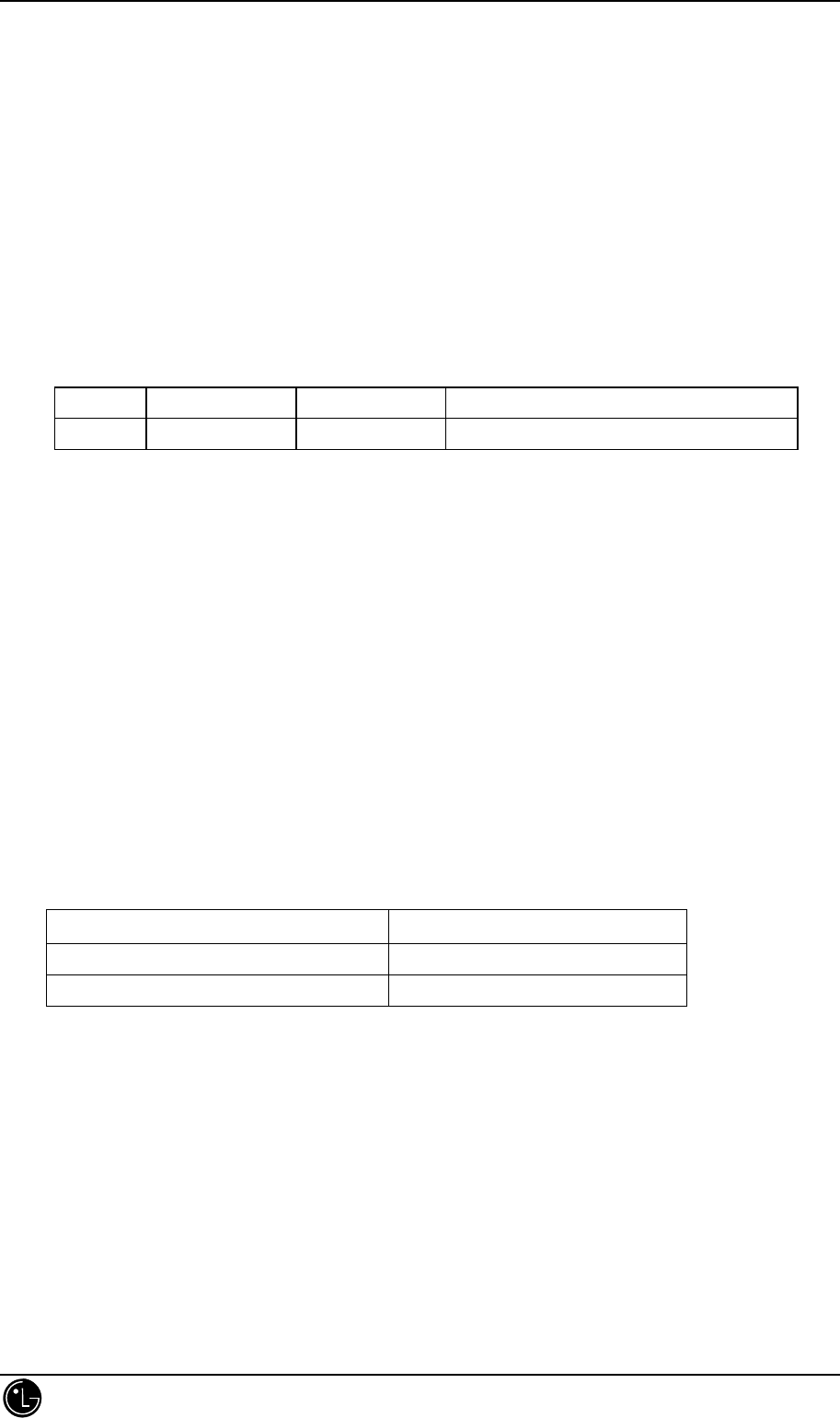
LGC-800W
LG Information & Communications, Ltd. - 8 -
4. Specification
4.1 General Specification
4.1.1 Transmit/Receive Frequency Interval : 45 MHz
4.1.2 Number of Channels (Channel Bandwidth) : 20 CH
4.1.3 Operating Voltage : DC 3.0V
4.1.4 Battery Power Consumption : DC 3.5V
SLEEP IDLE MAX POWER
CDMA 2 mA120 mA 800 mA (24 dBm)
4.1.5 Operating Temperature : -30
°
~ +60
°
4.1.6 Frequency Stability :
¡¾
0.5PPM
4.1.7 Antenna : Retractable Type (Herical+Whip), 50
Ω
4.1.8 Size and Weight
1) Size : 105545519.9§§
2) Weight : 104g (About)
4.1.9 Channel Spacing : 1.25MHz
4.1.10 Battery Type, Capacity and Orerating Time.
Unit = Hours : Minutes
State Retracted (900mAh)
Stand-By Time 150
Talk Time 2:20
4.2 Receive Specification
4.2.1 Frequency Range : 869.82MHz ~ 893.190MHz
4.2.2 Local Oscillating Frequency Range : 966.88MHz
¡¾
12.5MHz
4.2.3 Intermediate Frequency : 85.38MHz
4.2.4 Sensitivity : -104dBm(C/N 12dB or more)

LGC-800W
LG Information & Communications, Ltd. - 9 -
4.2.5 Selectivity : 3dB C/N Degration(With Fch
¡¾
1.25 kHz : -30dBm)
4.2.6 Spurious Wave Suppression : Maximum of -80dB
4.2.7 CDMA Input Signal Range
• Dynamic area of more than -104~ -25 dB : 79dB at the 1.23MHz band.
4.3 Transmit Specification
4.3.1 Frequency Range : 824.820MHz ~ 848.190MHz
4.3.2 Local Oscillating Frequency Range : 966.88 MHz
¡¾
12.5 MHz
4.3.3 Intermediate Frequency : 130.38 MHz
4.3.4 Output Power : 0.2W
4.3.5 Interference Rejection
1) Single Tone : -30dBm at 900 kHz
2) Two Tone : -43dBm at 900 kHz & 1700kHz
4.3.6 CDMA TX Frequency Deviation : +300Hz or less
4.3.7 CDMA TX Conducted Spurious Emissions
• 900kHz : - 42 dBc/30kHz below
• 1.98MHz : - 54 dBc/30kHz below
4.3.8 CDMA Minimum TX Power Control : - 50dBm below
4.4 MS (Mobile Station) Transmitter Frequency
FA NO. CH.NO. CENTER FREQUENCY FA NO. CH.NO. CENTER FREQUENCY
1
2
3
4
5
6
7
8
9
10
1011
29
70
111
152
193
234
275
316
363
824.640 MHz
825.870 MHz
827.100 MHz
828.330 MHz
829.560 MHz
830.790 MHz
832.020 MHz
833.250 MHz
834.480 MHz
835.890 MHz
11
12
13
14
15
16
17
18
19
20
404
445
486
527
568
609
650
697
738
779
837.120 MHz
838.350 MHz
839.580 MHz
840.810 MHz
842.04 MHz
843.270 MHz
844.500 MHz
845.910 MHz
847.140 MHz
848.370 MHz

LGC-800W
LG Information & Communications, Ltd. - 10 -
4.5 MS (Mobile Station) Receiver Frequency
FA NO. CH.NO. CENTER FREQUENCY FA NO. CH.NO. CENTER FREQUENCY
1
2
3
4
5
6
7
8
9
10
1011
29
70
111
152
193
234
275
316
363
869.640 MHz
870.870 MHz
872.100 MHz
873.330 MHz
874.560 MHz
875.790 MHz
877.020 MHz
878.250 MHz
879.480 MHz
880.890 MHz
11
12
13
14
15
16
17
18
19
20
404
445
486
527
568
609
650
697
738
779
882.120 MHz
883.350 MHz
884.580 MHz
885.810 MHz
887.04 MHz
888.270 MHz
889.500 MHz
890.910 MHz
892.140 MHz
893.370 MHz
4.6 Desktop Charger : See Appendix
4.7 Travel Charger : See Appendix
4.8 Cigar Lighter Charger : See Appendix
4.9 Hands-Free Kit : See Appendix
4.9 Data Cable : See Appendix

LGC-800W
LG Information & Communications, Ltd. - 11 -
5. Installation
5.1 Installing a Battery Pack
1) The Battery pack is keyed so it can only fit one way. Align the groove in the battery pack with the rail on the
back of the phone until the battery pack rests flush with the back of the phone.
2) Slide the battery pack forward until you hear a “click”, which locks the battery in place.
5.2 For Desktop Charger Use
1) Plug the charger into a wall outlet. The charger can be operated from either a 110V or a 220V source. When
AC power is connected to the desktop charger, both the green and red LED’s blink once.
2) Insert the phone with the installed battery pack or a spare battery pack into the individual battery pack slot.
Red light indicates battery is being charged.. Green light indicates battry is fully charged.
5.3 For Mobile Mount
5.3.1 Installation Position
In order to reduce echo sound when using the Hands-Free Kit, make sure that the speaker and microphone are not
facing each other and keep microphone a generous distance from the speaker.
5.3.2 Cradle Installation
Choose an appropriate flat surface where the unit will not interface with driver’s movement or passenger’s
comfort. The driver/user should be able to access the phone with ease. Using the four self-tapping screws
provided, mount the supplied braket on the selected area. Then with the four machine screws provided, mount the
counterpart on the reverse side of the reverse side of the cradle. Secure the two brackets firmly together by using
the two bracket joint screws provide. The distance between the cradle and the interface box must not exceed the
length of the main cable.
5.3.3 Interface Box
Choose an appropriate flat surface ( somewhere under the dash on the passenger side is preferred ) and mount the
IB bracket with the four self-tapping screws provided. Clip the IB into the IB bracket.
5.3.4. Microphone Installation
Install the microphone either by cliiping I onto the sunvisor (driver’s side) or by attaching it to door post
(driver’s side), using a velcno adhesive tape (not included).

LGC-800W
LG Information & Communications, Ltd. - 12 -
5.3.5 Cable Connections
5.3.5.1 Power and Ignition Cables
Connect the red wire to the car battery positive terminal and the black wire to the car ground. Connect the green
wire to the car ignition sensor terminal. ( In order to operate HFK please make sure to connect green wire to
ignition sensor terminal.) Connect the kit’s power cable connector to the interface box power receptacle.
5.3.5.2 Antenna Cable Connection
Connect the antenna coupler cable connector from the cradle to the external antenna connector. ( Antenna is not
included.)
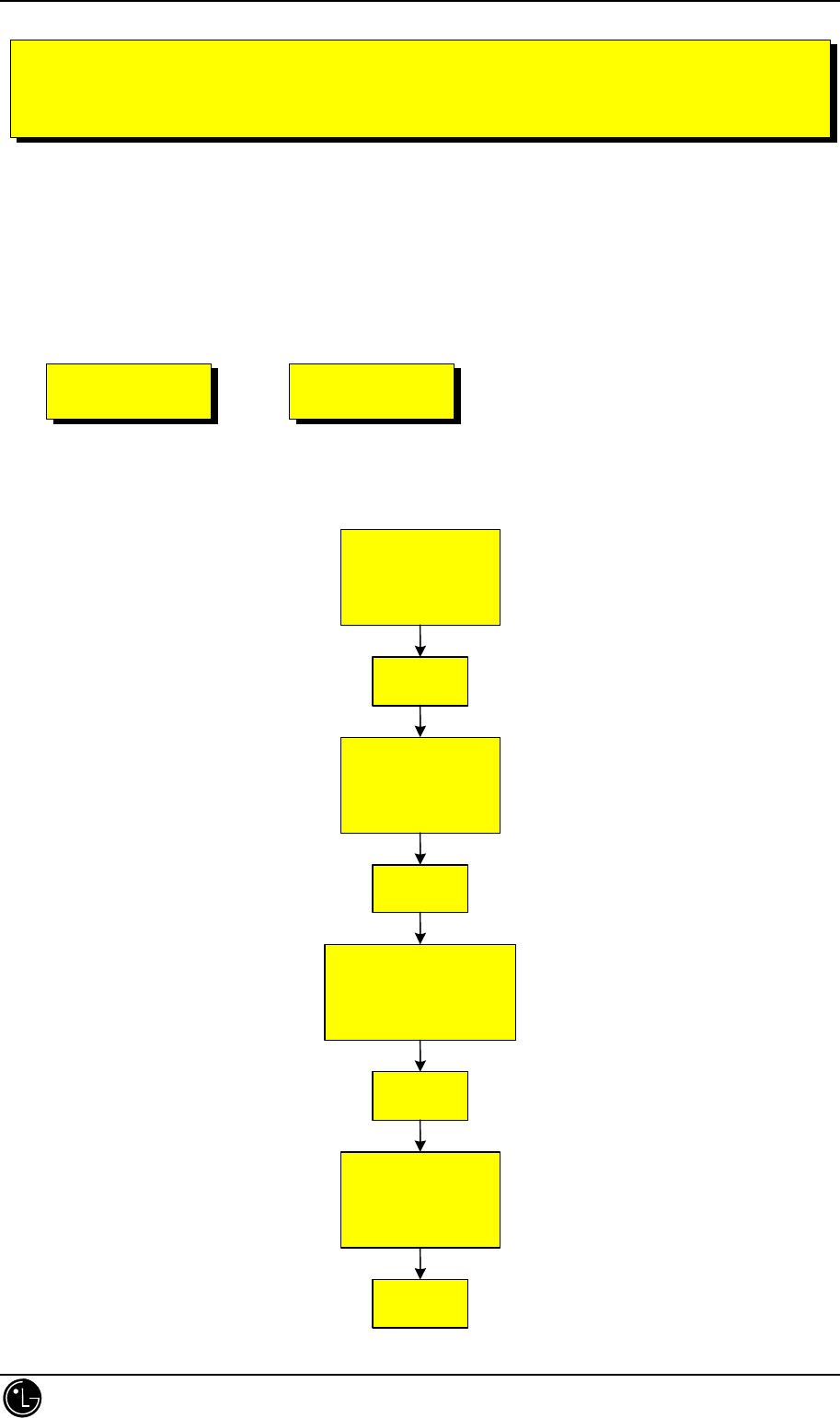
LGC-800W
LG Information & Communications, Ltd. - 13 -
1. Telephone Number Inputting Method
Telephone numbers can be inputted as follows in LGC-800W.
• Press MENU+0 and then, press the password made up of six digits(Default:000000).
• Press 6 when the menu is displayed as illustrated on the followi type.
è
• NAM1 Setting Õ NAM2 Setting.
• Select one NAM and then, input as shown in the following diagram (registration required from NAM1).
PHONE
MODEL
7
SLOT CYCLE
INDEX
2
[SAVE]
NAM1.
PHONE NUMBER
0000000000
NAM1.
NAME
POWER 017
[SAVE]
[SAVE]
[SAVE]
CHAPTER 2. NAM Input Method
(Inputting of telephone numbers included)
1 : Serv Mode ç
2 : Pref. Mode 1 : Short NAM ç
2 : Ext. NAM
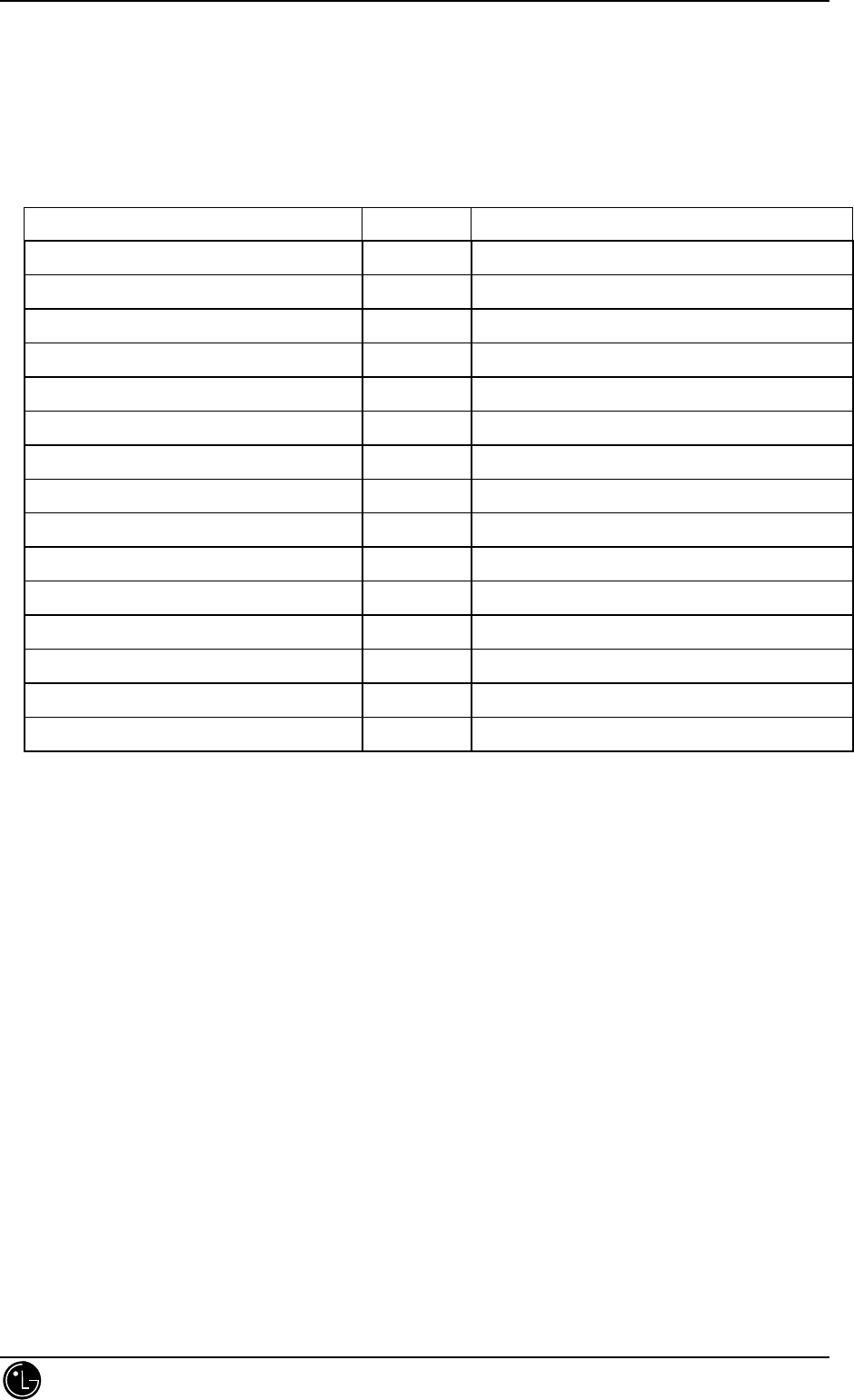
LGC-800W
LG Information & Communications, Ltd. - 14 -
2. NAM Program Method
The NAM inputting method of LGC-800W is as follows.
After input Telephone Number as stage1 then you will see massage ask whether you will do NAM program or
not.
Press more edit key.
FUNCTION DEFAULT DESCRIPTION
SERVICE SECURITY CODE 000000 Enter Service Sec. code
NAM1 MOBILE COUNTRY CODE 450 Enter Mobile Country Code
NAM1 MOBILE NETWORK CODE 22 Enter Mobile Network Code
NAM1 CDMA SID 1 1700 Enter CDMA Home System I.D.#1
NAM1 CDMA NID 1 1 Enter CDMA Network I.D.#1
NAM1 CDMA SID 2 1700 Enter CDMA Home System I.D.#2
NAM1 CDMA NID 2 2Enter CDMA Network I.D.#2
NAM1 CDMA SID 3 1700 Enter CDMA Home System I.D.#3
NAM1 CDMA NID 3 3Enter CDMA Network I.D.#3
NAM1 CDMA SID 4 1700 Enter CDMA Home System I.D.#4
NAM1 CDMA NID 4 65535 Enter CDMA Network I.D.#4
NAM1 SYSTEM A PRIMARY CHAN 400 Enter System A Primary Channel
NAM1 SYSTEM B PRIMARY CHAN 400 Enter System B Primary Channel
NAM1 SYSTEM A SECONDARY CHAN 400 Enter System A Secondary Channel
NAM1 SYSTEM B SECONDARY CHAN 400 Enter System B Secondary Channel
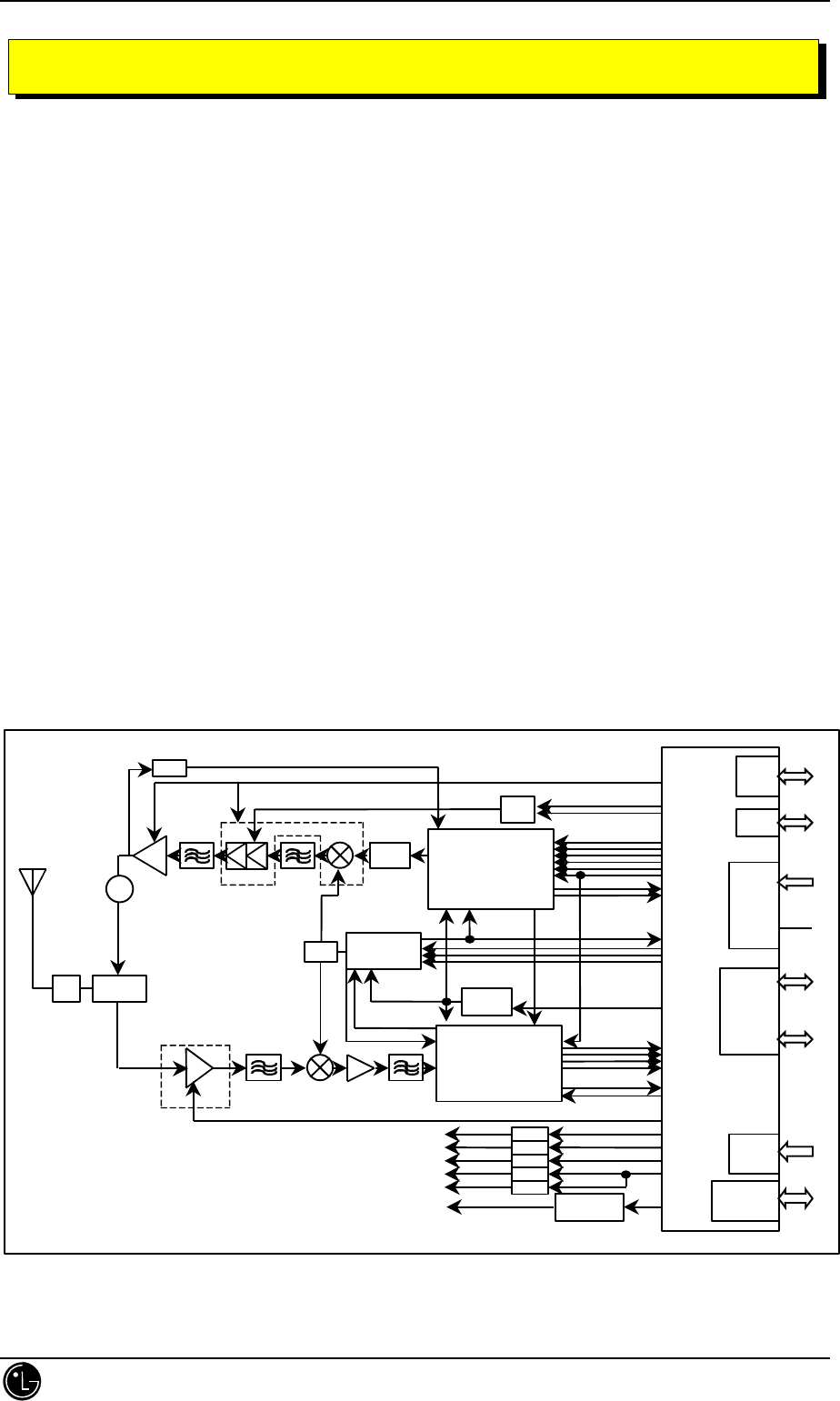
LGC-800W
LG Information & Communications, Ltd. - 15 -
1. RF Transmitter and Receiver
1.1 Overview
The RF transceiver (transmitter and receiver) employs Super-Heterodyne system. The frequency ranges of
transmitter and receiver are 824.640~848.370 MHz and 869.640~893.370 MHz respectively. The block diagram
of this mobile phone is shown in figure 1.
RF signals received from the antenna are fed into the mixer through the duplexer. Mixer converts RF signals into
intermediate frequency (IF) signals by mixing RF signals with signals from local Oscillator (VCO). IF signals are
sent to AGC (Auto Gain Controller) contained in the IFR (Internediate Frequency Receiver) through bandpass
filter (BPF). The signals are converted to baseband signals and finally sent to MSM.
In the case of transmission, IFT (Internediate Frequency Transmitter) receives modulated digital signals from the
MSM and creates analog baseband signals using the digital/analog converter (DAC, D/A Converter). Baseband
signals are changed into IF siganls, and these signals are fed into Mixer after adjusting the gain with AGC in IFT.
If signals are converted into RF signals in the Mixer, and the gain of signals are adjusted once more by RF
AGC. RF signals are amplified by drive anmplifier and, thereafter, fed into Power Amplifier. Amplified signals
are sent out to the cell site via the antenna after going through the isolator and duplexer.
Block Diagram of RF Tansmitter and Receiver Circuit
CHAPTER 3. Circuit Description
RX, PLL
IFT3000
IFR3000
M
S
M
3
0
0
0
VCO/PLL
DPX
ANT
CP
PAM
CODEC
TX
IFT/IFR
ISO
PA

LGC-800W
LG Information & Communications, Ltd. - 16 -
1.2 Description of Receiver
1.2.1 Duplexer (F103)
The duplexer separates transmitted and received signals in order to be operated in full duplex mode using
common antenna.
The duplexer consists of receive bandpass filter (BPF) and the transmit bandpass filter (BPF). The transmit BPF
is used to suppress noises and to keep spurious waves of transmitter from entering receiver, which prevents
receiver sensitivity degradation. The receive BPF blocks the trnasmitted signals from entering the receiver end,
which improves sensitivity characteristics and rejects image signals on IF signals.
Insertion loss (IL) of transmit BPF is 3.6dB (Max), whereas IL of the receiver is 4.3dB (Max). The attenuation of
the transmit BPF for receiving signals in is 43dB (Min), and is over 27 dB beyond 1.6GHz. The attenuation of
the transmit BPF for transmitting signals is 50dB or more, and attenuation for local oscillating signal is at least
30 dB.
1.2.2 Low Noiser Amplifier (LNA)
RF signals from Duplexer are fed into LNA through input matching circuit. The signals which were maximally
amplified to reduce noise pass through BPF and are sent to mixer. The noise figure of LNA is 1.5 dB and gain is
19dB. The loss of image frequency rejection filter is 3dB (max), attenuation for transmitting signal (824-849
MHz) is at least 25dB.
1.2.3 Mixer
Signals from BPF are fed into input port of Mixer and mixed with local oscillating signal of UHF band, resulting
in sum and difference signals. This is a double balnaced mixer, which is used to prevent received signal
distorsion resulting from the insertion of local signal into iuput and output port. When RF signals and local signal
are mixed, two signals are made from the nonlinear characteristic of transistor. Among the two signals, the
signal of 85.38 MHz is selected. L, C circuit of balanced type improves the frequency selection characteristic by
operating as resonant circuit and matching circuit.
The noise figure of Mixer and IF AMP is 6dB, and the conversion gain is 13dB±4.5dB.
1.2.4 Intermediate Frequency Circuit
Signals converted by mixer are sent to BPF which has at least 30 dB attenuation for outside band and improves
sensitivity of receiver. IF signals of 85.38 MHz are amplified or attenuated by AGC according to the signal
level. The control range of AGC is ±45 dB. This is a compensating circuit to prevent sensivity degradation due to
the variation of received signal according to the position of mobile station.
The signals from AGC circuit are sent to QPSK demodulator and converted baseband signals by mixer.

LGC-800W
LG Information & Communications, Ltd. - 17 -
Demodulated signals are sent to each lowpass filter of IFR.
1.3 Description of IFT/IFR Transceiver
IFT consists of AGC, Mixer, Buffer, Mode Controller, ADC ( Analog Digital Converter), and IFR consists of
AGC, IF VCO, Clock Distribution Circuit, QPSK Demodulator.
1.3.1 Digital Conversion Circuit of CDMA Received Signal
After frequency conversion, the frequency band of CDMA baseband is from 1 kHz to 630 kHz. CDMA baseband
filter defines signals over 750 kHz as unnecessary signals. Besides IF filter, this baseband filter improves the
ability to select correct signals from jamming effect due to unnecessary signals. I_OFFSET and Q_OFFSET are
also used to improve sensitivity by controlling DC offset of QPSK. This control signal is made in MSM of digital
circuit.
Analog I/Q baseband signals are converted to digital signals by two 4bit ADC. Digital signals are sent out at the
falling edge of 9.8304 MHz clock signal. The signal of 9.8304 MHz coming from CHIPx8 stems from VCTCXO
(Voltage Controlled Temperature Compensated Oscillator), of which frequency is 19.68 MHz.
1.3.2 Analog Conversion Ciruit of CDMA Transmitted Signal
IFT receives digital baseband I/Q signals from MSM. 8bit I/Q data are sent into DAC (Digital Analog Converter)
of B/B ASIC after they are multiplexed. Data are sent to I DAC at the rising edge, and sent to Q DAC at the
falling edge. I and Q data have time difference of 1/2 times of clock cycle.
1.4 Description of Transmitter
1.4.1 Modulation and AGC Circuit
Modulation and AGC circuits consist of modulator, mixer, and AGC circuit and Upconverter.
I/Q data are modulated to IF signals of 130.38 MHz. These signals are fed into AGC. AGC uses gain control
signal, or TX_AGC_ADJ, for control of gain. Output signals of AGC are sent to the input port of Upconverter.
Upconverter makes sum and difference signals by mixing IF signal with local oscillating signal of UHF band.
Local oscillating signal made in PLL is divided into transmitter local signal and receiver local signal. When IF
signal and local signal are inserted into transistor, two mixed signals are made by the nonlinear characteristic of
transistor. Among the two signals, the signal of UHF (824.640~848.370 MHz) is sent out as main signal.
1.4.2 Bandpass Filter of Transmitter
Output signal of Upconverter is sent to bandpass filter of transmitting band. This filter is SAW filter ( Surface

LGC-800W
LG Information & Communications, Ltd. - 18 -
Acoustic Filter), of which IL is at most 3.5 dB and attenuation for receving signal and local oscillating signal is at
least 30 dB. The siganl coming from BPF is sent to Power AMP.
1.4.3 Power Amplifier and Power Detection Circuit
RF signal which was filtered by the BPF is amplified at the Power Amplifier. After the signal passes through
Isolator and Duplexer , it is radited at the antenna to the base station. The ouput power is +24dBm. Power
amplifier is designed with GaAs FET.
Amplified signal is feedbacked to MSM, modulation and AGC circucit for the detection and compensation of
ouput power error which comes from the power rising due to temperature and from ripple due to mismatching.
Rated Power of Isolator is 5 Watt and its isolation is at least 15dB. Without Isolator, Power amplifier can be
hurted by the reflection power. Isolator is, therefore, inserted between Power AMP and Duplex to prevent PA
failer. Duplexer uses dielectric filter which makes transmitted and received signals pass and other unnecessary
signals stop. IL at the receiving band is about 3.6 dB or less, and connected to antenna with RF cable.
1.5 Frequency Conversion Circuit
1.5.1 VCTCXO (Voltage Control Temperature Compensation Crystal Oscillator)
VCTCXO is a source of clock signals. These signals are used for the UHF mixer, modulation and
demodulation, baseband reference clock. It is temperature compensated crystal oscillator and has stability of 2.5
ppm at the operating temperature(-30°C~60°C). The variable frequency range according to the supply voltage is
240 Hz. The DC supply voltage is 3 V.
1.5.2 UHF Band Mixer
This circuit consists of PLL (Phase Locked Loop), VCO of which center frequency is 967 MHz, Loop Filter.
Reference frequency is 30 kHz. Local oscillating signal with 0 phase error is generated by comparing reference
signal with PLL input signal which is made by dividing the signal of VCO. This local signal is used commonly
for both transmitter and receiver.
2. Digital/Voice Processing Part
2.1 Overview
The digital/voice processing part processes the user's commands and all the digital and voice signal processing.
The digital/voice processing part is made up of a keypad/LCD, receptacle part, voice processing part, mobile

LGC-800W
LG Information & Communications, Ltd. - 19 -
station modem, memory part, and power supply part.
2.2 Configuration
2.2.1 Keypad/LCD and Receptacle Part
This is used to transmit keypad signals to MSM3000. It is made up of a keypad backlight part that illuminates the
keypad, LCD part that displays the operation status onto the screen, and a receptacle that receives and sends out
voice and data with external sources.
2.2.2 Voice Processing Part
The voice processing part is made up of an audio codec used to convert MIC signals into digital voice signals
and digital voice signals into analog voice signals, amplifying part for amplifying the voice signals and sending
them to the ear piece, amplifying part that amplifies ringer signals coming from MSM3000, and amplifying part
that amplifies signals coming out from MIC and transferring them to the audio processor.
2.2.3 MSM (Mobile Station Modem) Part
MSM is the core elements of CDMA terminal and carries out the functions of CPU, encoder, interleaver,
deinterleaver, Viterbi decoder, Mod/Demod, and vocoder.
2.2.4 Memory Part
The memory part is made up of a flash memory which stores program, SRAM which stores data, and EEPROM.
2.2.5 Power Supply Part
The power supply part is made up of various power generating circuit.
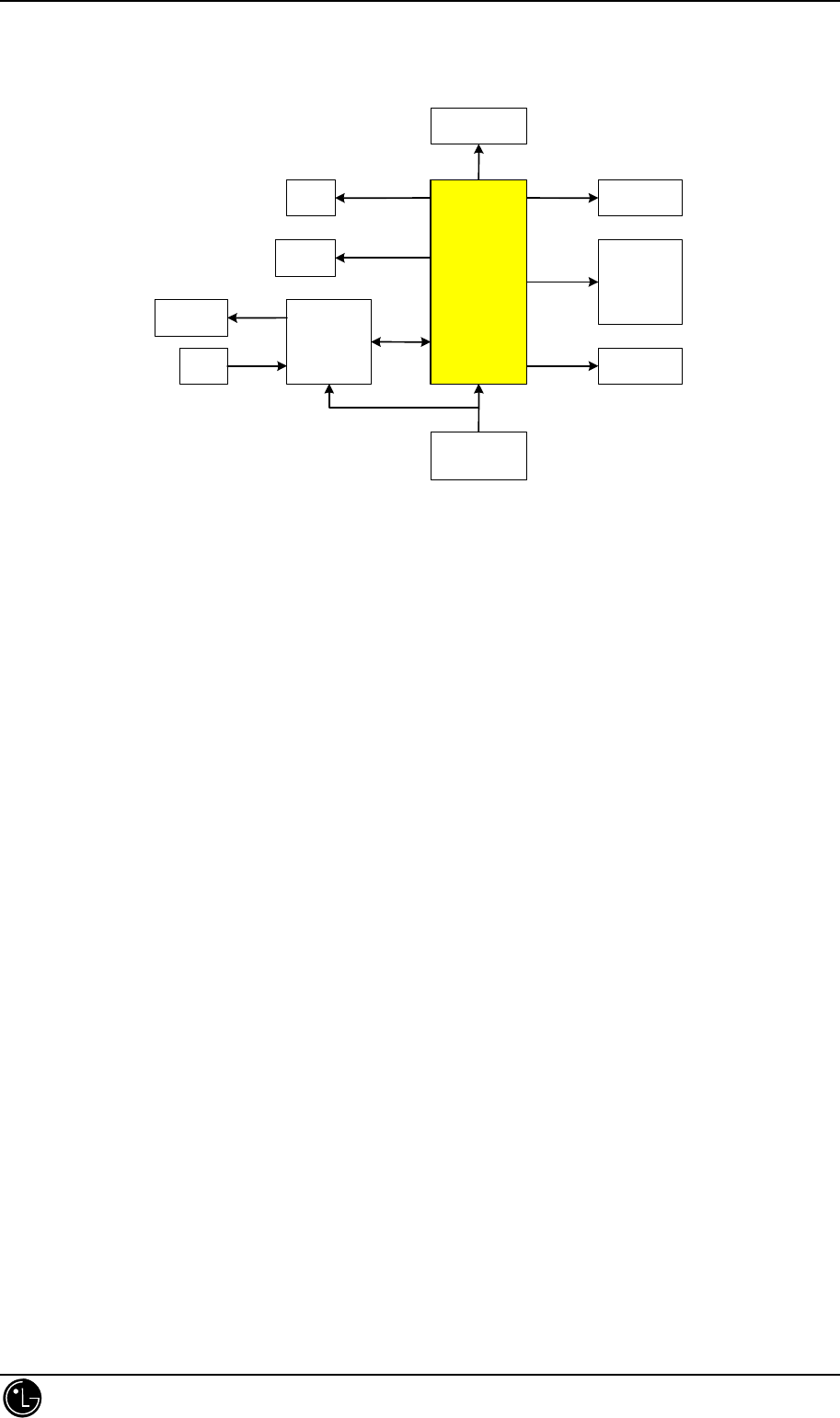
LGC-800W
LG Information & Communications, Ltd. - 20 -
2.3 Circuit Description
Ringer
FLASH
Memory
&
SRAM
EEPROM
Receptacle
Power
Supply
AUDIO
Processor
M
S
M
3
0
0
0
Earpiece
MIC
LCD
Keypad
Block Diagram of Digital/Voice Processing Circuit
2.3.1 Keypad/LCD and Receptacle Part
When the keypad is pressed, the key signal is sent to MSM3000 for processing and 15 LEDs lights up the
keypad. The terminal status and operation are displayed on the screen of LCD for the user. Moreover, it
exchanges audio signals and data with external sources through the receptacle.
2.3.2 Voice Processing Part
MIC signals are amplified with OP AMP, inputted into the audio codec, and converted into digital signals. Then,
they are inputted to MSM. In addition, digital audio signals coming from MSM are converted into analog signals
after going through the audio codec. These signals are amplified at the audio AMP and transferred to the ear
piece. Then, the signals of ringer activate the ringer by activating Q705 with signals generated in the timer in
MSM.
2.3.3 MSM Part
MSM3000, which is U400, is the core element of CDMA system terminal. It is made up of a CPU, encoder,
interleaver, deinterleaver, Viterbi decoder, MOD/DEM, and vocoder. Digital voice data are encoded with
variable-rate. They are, then, convolutionally encoded to detect and correct error. Coded symbols are interleaved
in order to cope with multi-path fading. Each data channel is scrambled by the long code PN sequence of the user
in order to ensure the confidentiality of calls. Moreover, binary quadrature codes based on Walsh functions are
used in order to discern each channel. Created data are modulated to 4-phase with one pair of Pilot PN code and I

LGC-800W
LG Information & Communications, Ltd. - 21 -
and Q data are generated .
In receiving, I and Q data are demodulated into symbols by the demodulator and then, de-interleaved in opposite
procedure to the case of transmission. Digital Voice data are generated from Vocoder after detecting and
correcting the error of Viterbi Decoder.
2.3.4 Memory Part
Operatin program is stored in the Flash memory, and nonerasable data such as unique phone nulber is stored in
the EEPROM. Other data generated in phone operation is temporarily stored in SRAM.
2.3.5 Power Supply Part
DC/DC Converter supplys 5 V to Power AMP, and regulators generate various DC voltage such as 3 V supply
used for RF/IF and Digital/Audio Processor. These DC/DC converter and regulators use 3.6 V battery.
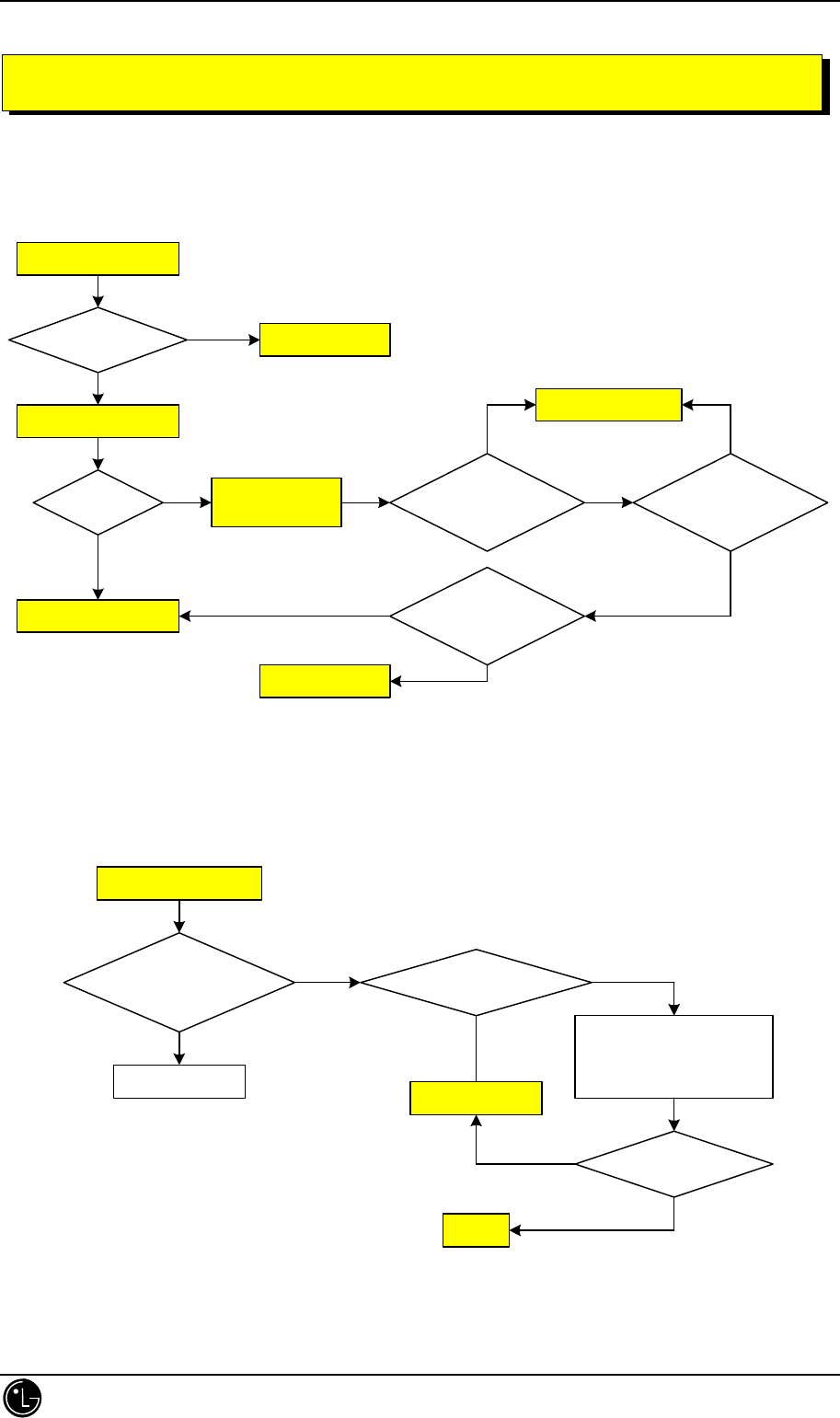
LGC-800W
LG Information & Communications, Ltd. - 22 -
1. When power isn't "Turn On".
START
Recharge Batt.
Batt. Volt
< 3.6V
Yes
No Change U703
Voltage at
16 pin of U703
< 3.6V
No
Yes
Voltage at
9 pin of U703
< 3.3V
Change U605
Voltage at
5 pin of U605
< 3.3V
Change Sub. Board
Turn On Yes
No
Change Main Board
Change
Old Sub. Board
Yes
Yes
No
Yes
No
2. When LCD isn't displayed.
START
Refer to [1]
Circuit to supply
power nominal?
Yes
No Check pins of con972
or
Reconnect con972
LCD supplied power No
Yes
Good
LCD display?
Yes
No
Change LCD
CHAPTER 4. Trouble Shooting
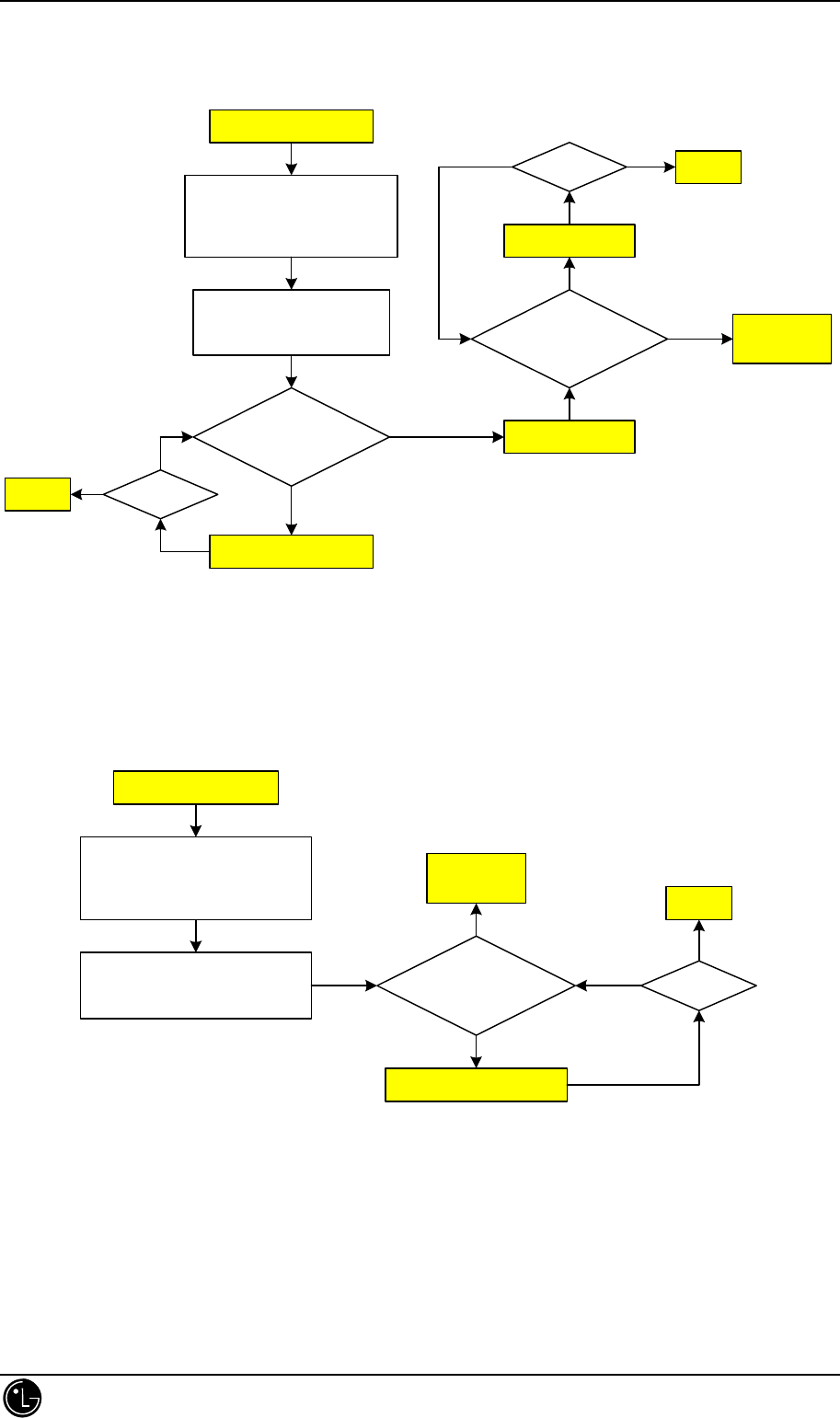
LGC-800W
LG Information & Communications, Ltd. - 23 -
3. When Tx Audio (MIC) isn't transmitted.
START
Sinewave
appear at 3 pin
of U801
Yes
No
Change MIC unit
Setup Test mode
Set Tx Audio unmuted and
set path to L/T Audio out
Supply 1kHz/-20dBm
to L/T by AF Gen. Sinewave
appear at 40 pin
of U802
No
Change U802
Change U801
Yes
Operation
No
Yes
Good
Operation Yes Good
No
Change
Sub Board
4. When Rx Audio (Speaker) isn't heard.
START
Change Earpiece unit
Setup Test mode
Set Rx Audio unmuted and
set path to L/T Audio In
Supply RF signal of -20dBm
with Dev. 8kHz at 1kHz
Sinewave
appear at 44 pin
of U802
No
Yes
No
Change
Sub Board
Operation
Yes
Good
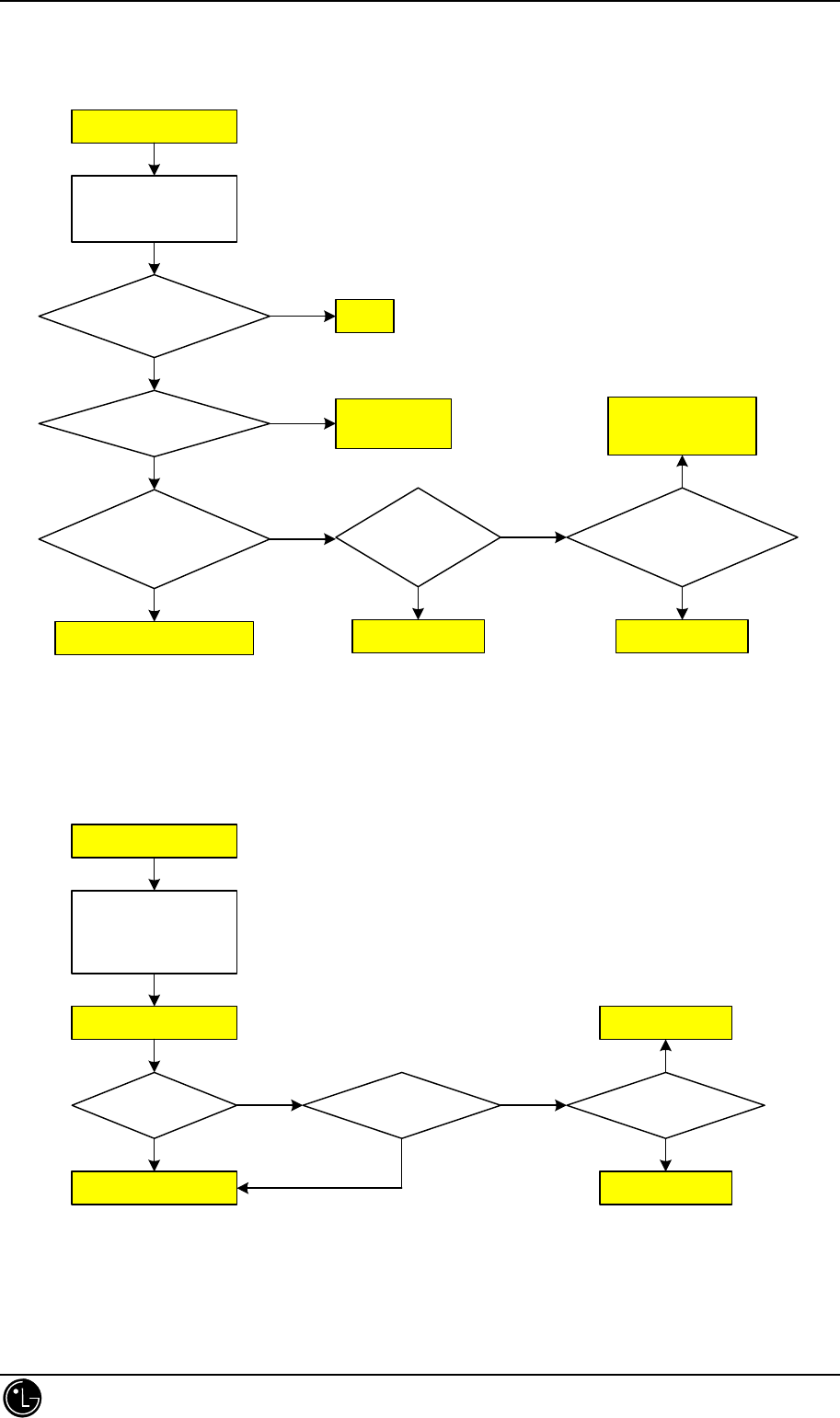
LGC-800W
LG Information & Communications, Ltd. - 24 -
5. When Keytone isn't heard.
START
Good
Keytone heard
at handset?
Yes
No
Supply Power
to Handset
Check signal
at R976?
Change Earpiece
Change
Main Board
No
Yes
Rectangular
wave appear 5/8 pin
of U971
No
Yes
Voltage
of U802
= 3.3V ?
Change U802
No
Yes
Change U971
Yes
Rectangular
wave appear 4 pin
of U971
Check Ext. Ring
Ambient circuit
No
6. When Buzzer isn't rung.
START
Paging to Handset
with HP8924C
Service option 1.
Change Q803
Yes
Change Main Board
No
Check Q803
V_H at Base Rect. wave
at Emitter
Yes
No
3.6V
at Collector
Yes
No
Change Q801
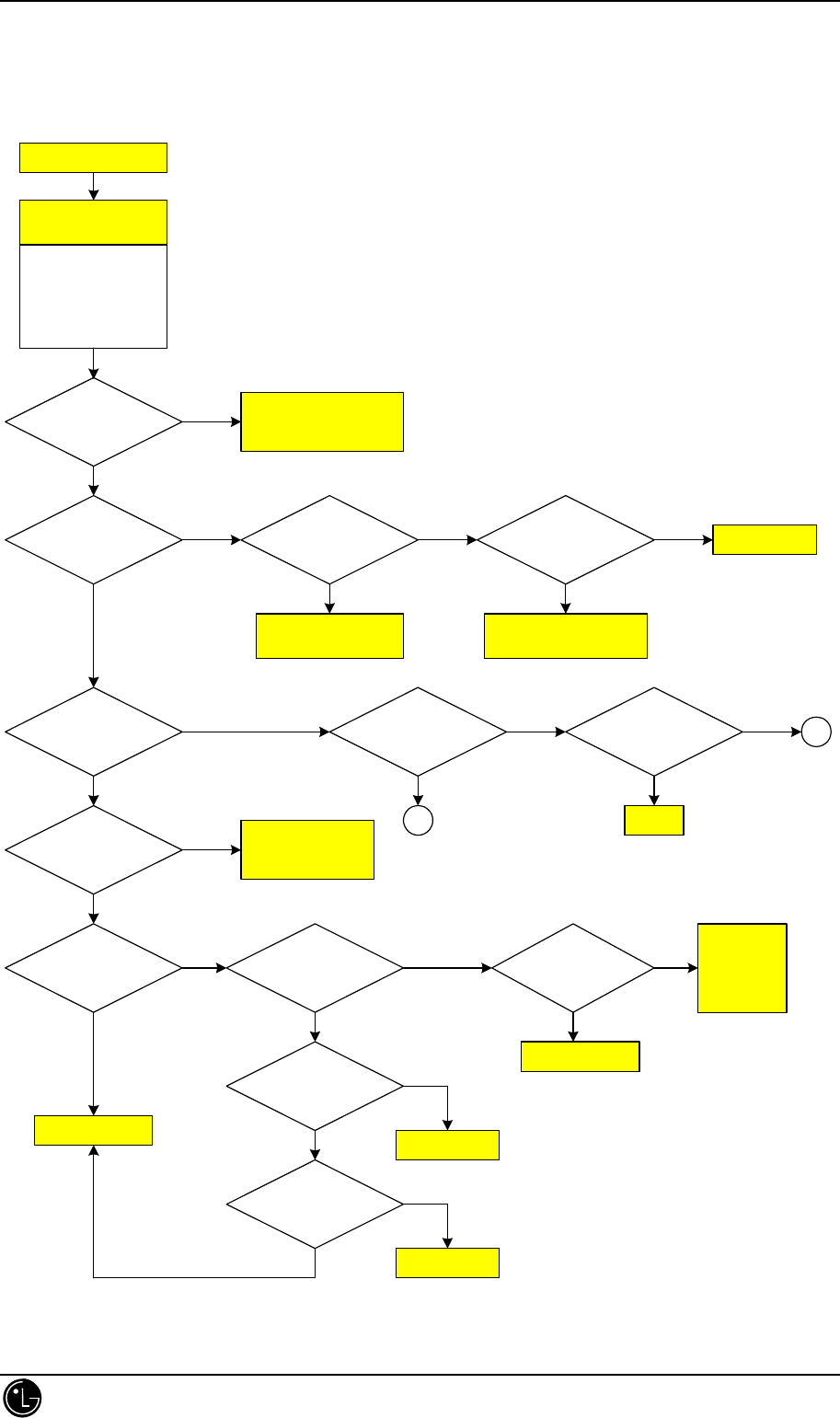
LGC-800W
LG Information & Communications, Ltd. - 25 -
7. When Tx carrier isn't transmitted.
START
Setup Test mode
with DM
* Mode offline-a
* load-sync #ch
* carrier on
* satoff
* set-attn 0
Check BBA &
Tx Attenuator circuit
Tx IF freq.
appear at 1/2 pin
of U202
Yes
No
Tx IF freq.
appear at 1/2 pin
of U201
Yes
No
Voltage
at 4/7 pin of U202
= 3.6V
Yes
No
Check U601 &
Peripheral circuit
Voltage
at 8 pin of U202
= 2.7V
Yes
No
Check 35 pin of U501
& R511, C508
Change U202
RF freq.
appear at 5 pin
of F102
Yes
No
Voltage
at 7 pin of U201
= 3.6V
No
Yes
Check U601 &
Ambient circuit
RF freq.
appear at 5 pin
of F101
Yes
No
B
RF freq.
appear at 25 pin
of CON1
No
Yes
C
Good
UHF freq.
appear at 5 pin
of U201?
No
Yes
Change U201
UHF freq.
appear at 6 pin
of U401?
No
UHF freq.
appear at collector
of Q401?
No
Yes
Yes
Change Q401
UHF freq.
appear at collector
of Q402?
No
Yes
Voltage
at 4 pin of U401
= 3.3V
Yes
No Check
U602 &
Peripheral
Circuit
Change U401
Change Q402
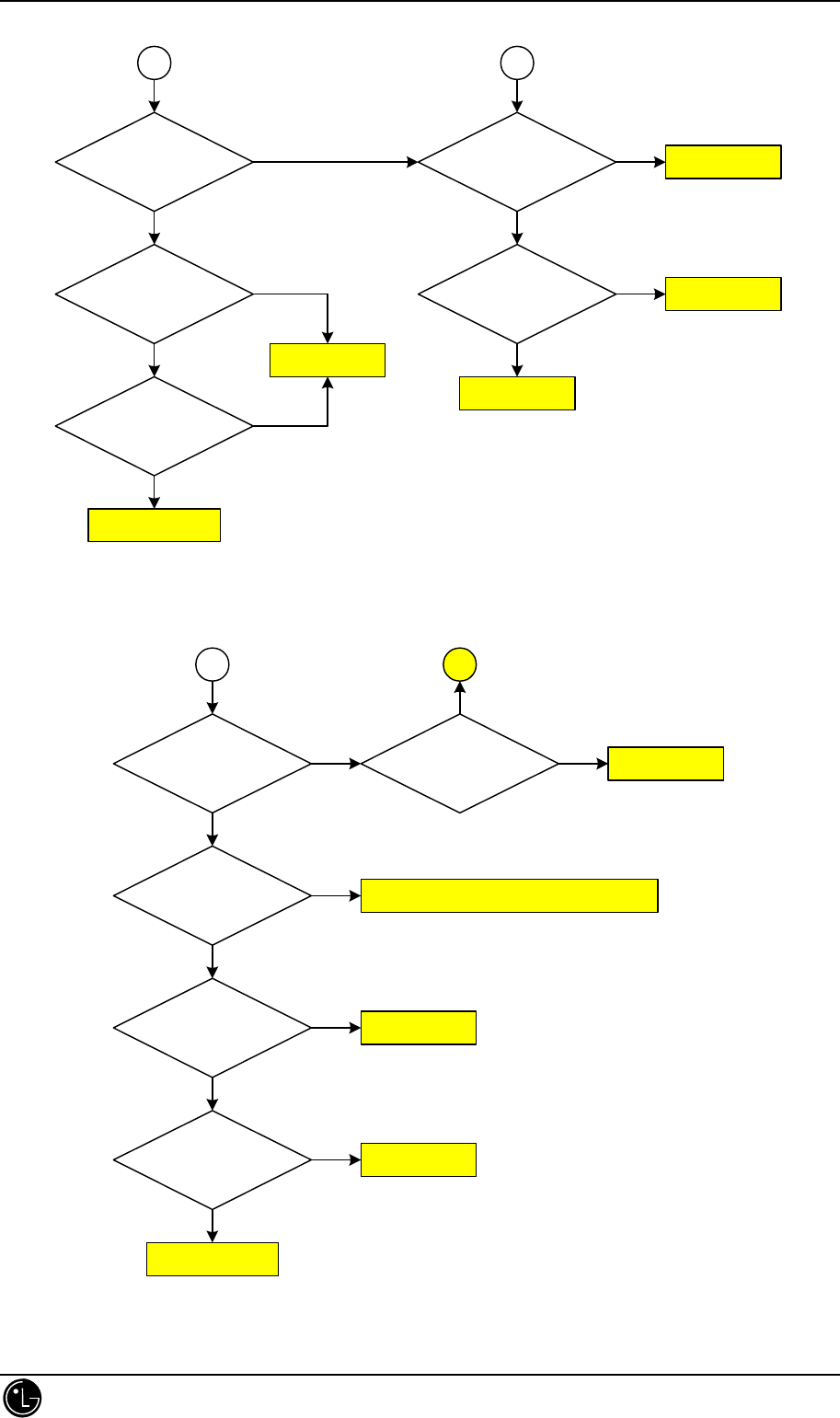
LGC-800W
LG Information & Communications, Ltd. - 26 -
Voltage at
3 pin of Q108
= 3.6V
No
Yes
Check U701
B
RF freq.
appear at 1 pin
of Q108?
No
Yes Change Q108
RF freq.
appear at 2 pin
of F101?
No
Yes
Change F101
Voltage at
5 pin of U601
= 3.6V
No Change U601
Yes
No
Yes
Voltage at
1 pin of U601
= 5V
Refer to [1]
D
Voltage at
4/8 pin of PWR1
= 5V
No
Yes
C
RF freq.
appear at 3 pin
of U102?
No
Yes
Change PWR1 or PWR detect circuit
No
Yes
Change U102
RF freq.
appear at 9 pin
of F103?
Voltage at
4 pin of Q101
= 5V
Yes
D
Change Q101
No
Yes
Change F103
Change CON1
RF freq.
appear at 25 pin
of CON1?
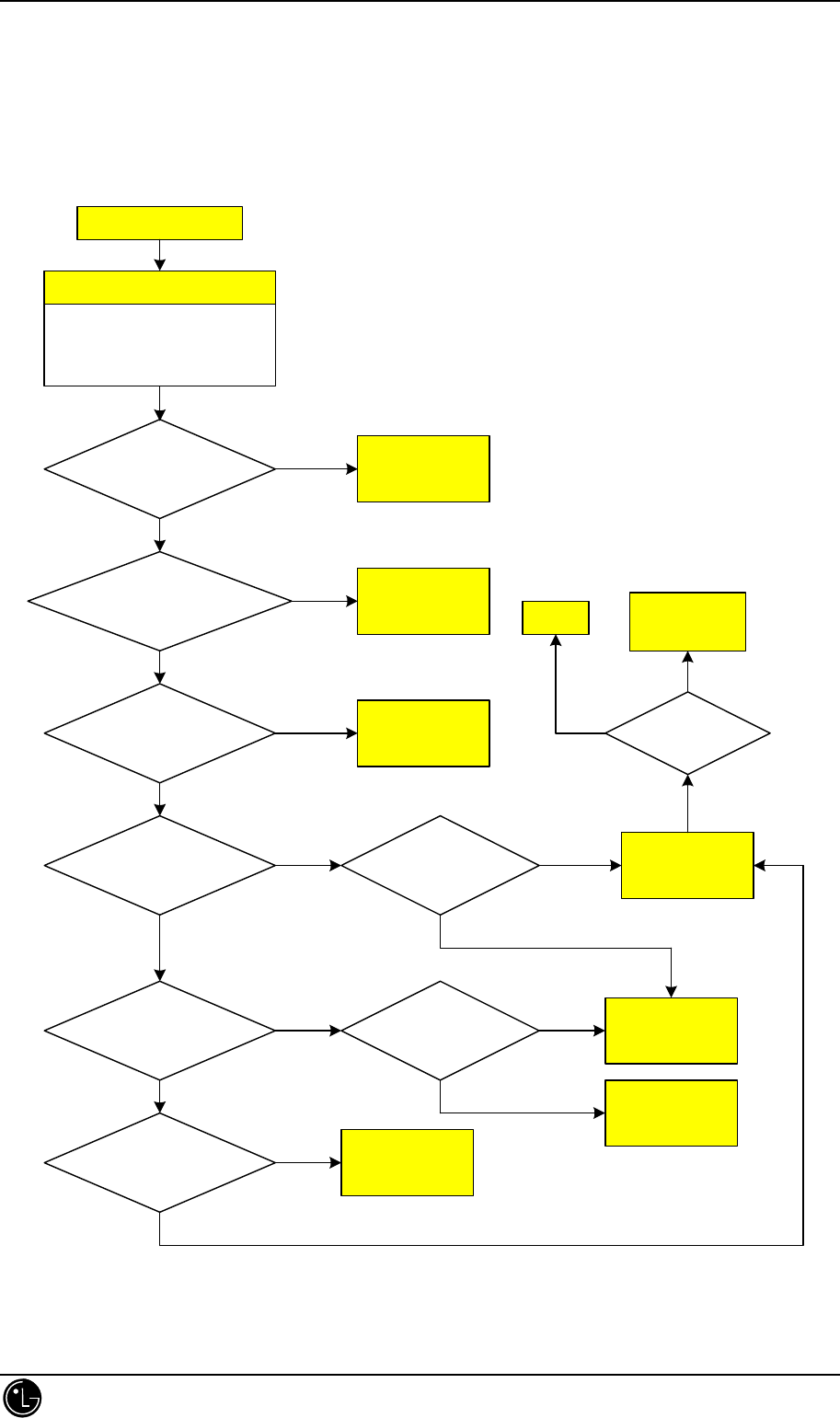
LGC-800W
LG Information & Communications, Ltd. - 27 -
8. When Rx sensitivity isn't normal.
START
Setup Test mode
* PWR On
* Supply to 25 pin of CON1
(only a carrier)
Check
Rx RF signal at 11 pin
of F103
Bad
Good
Check
Rx RF signal at collector
of F104
Bad
Good
Resolering or
Change F103
Check F104 &
Ambient circuit
Check
Rx RF signal at 1 pin
of U104
Bad
Good
Check Q105 &
Ambient circuit
Check
Rx IF signal at 6 pin
of U104
Bad
Good
Voltage
at 4 pin of U104
= 3.3V
No
Yes
Check U602 &
Ambient circuit
Check U104 &
Ambient circuit
Check
Rx IF signal at 9/10 pin
of U203
Bad
Good
Check U203 &
Ambient circuit
Check
Rx RF signal at 3 pin
of U104
Bad
Good
Voltage
4/5/7 pin of U401
= 3.3 V
No
Yes Check U402 &
Ambient circuit
Check Rx
Senditivity
Bad
Change
Main Board
OK
Good

LGC-800W
LG Information & Communications, Ltd. - 28 -
CHAPTER 5. Test Procedure

LGC-800W
LG Information & Communications, Ltd. - 29 -
1. Assembly and Disassembly Diagram
2. Block & Circuit Diagram
3. Part List
4. Component Layout
5. Accessories
- Desktop Charger
- Travel Charger
- Cigar Lighter Charger
- Hands Free Kit
APPENDIX